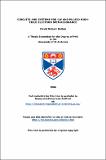Files in this item
Circuits and systems for CW and pulsed high-field electron spin resonance
Item metadata
| dc.contributor.advisor | Smith, Graham Murray | |
| dc.contributor.author | Bolton, David Robert | |
| dc.coverage.spatial | xviii, 325 p. | en_US |
| dc.date.accessioned | 2015-08-03T11:34:16Z | |
| dc.date.available | 2015-08-03T11:34:16Z | |
| dc.date.issued | 2006 | |
| dc.identifier | uk.bl.ethos.586899 | |
| dc.identifier.uri | https://hdl.handle.net/10023/7104 | |
| dc.description.abstract | This thesis is concerned with the design and realisation of components for a new state of the art 94GHz Electron Spin Resonance (ESR) spectrometer capable of operating in both pulsed and CW modes. The complete spectrometer is designed to provide phase coherent 1kW peak power sub-nanosecond π/2 pulses having variable duration and repetition rate. The mm-wave response of a paramagnetic sample to these pulses is detected with a superheterodyne detector. Such a system would offer a step change in performance, promising unprecedented resolution and sensitivity. These aims should be compared with the performance of commercial (Bruker) instruments capable of delivering 200mW 30ns π/2 pulses. For this type of system, both the long term (thermal) and short term (phase) stability of oscillators and sources employed are extremely important. Consideration of phase noise, frequency, tunability and power output shows that multiplied sources offer substantial benefits compared to fundamental sources. A delay line discriminator method of phase noise measurement, suitable for use with the low frequency oscillators is described and implemented. This is extended to 94GHz using a down convertor with a quasi-optically stabilised Gunn oscillator. These tools are used to select an optimum oscillator-multiplier combination to produce a low noise 94GHz source. Anew method of pulse generation, which has produced +23dBm peak power 250ps rectangular and 115ps Gaussian envelope phase coherent pulses, is described. These are believed to be the shortest phase coherent pulses at 94GHz available. This system will be used to provide ns pulses suitable for amplification to 1kW using a Klystron amplifier. A heterodyne detector has been constructed which employs the same oscillator/multiplier techniques identified above to produce the required local oscillator signal. It is demonstrated that by careful consideration of multiplication factors a system employing one variable and one fixed oscillator allows all the signals required in the spectrometer to maintain phase coherence. It is demonstrated that the complete demodulator responds to pulses on a ns time scale and has a noise temperature of 737K. | en_US |
| dc.language.iso | en | en_US |
| dc.publisher | University of St Andrews | |
| dc.subject.lcc | QC763.B7 | |
| dc.subject.lcsh | Electron paramagnetic resonance. | en_US |
| dc.subject.lcsh | Spectrometer -- Design and construction. | en_US |
| dc.subject.lcsh | Oscillators, Electric. | en_US |
| dc.subject.lcsh | Electron paramagnetic resonance spectrometry. | en_US |
| dc.title | Circuits and systems for CW and pulsed high-field electron spin resonance | en_US |
| dc.type | Thesis | en_US |
| dc.contributor.sponsor | Engineering and Physical Sciences Research Council (EPSRC) | en_US |
| dc.type.qualificationlevel | Doctoral | en_US |
| dc.type.qualificationname | PhD Doctor of Philosophy | en_US |
| dc.publisher.institution | The University of St Andrews | en_US |
This item appears in the following Collection(s)
Items in the St Andrews Research Repository are protected by copyright, with all rights reserved, unless otherwise indicated.

